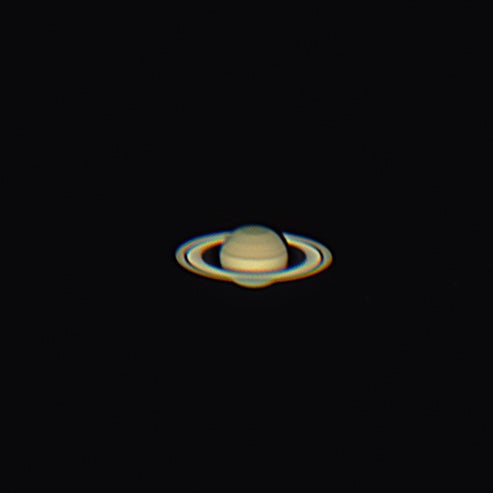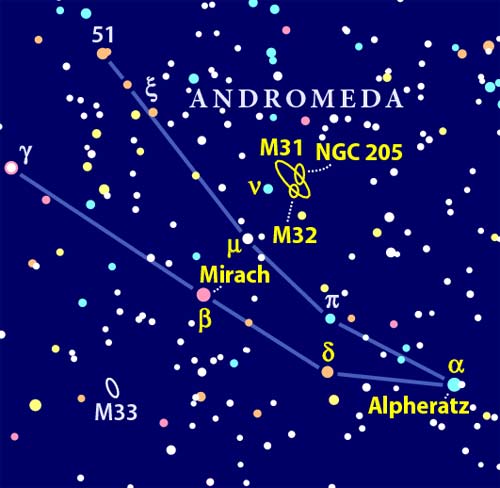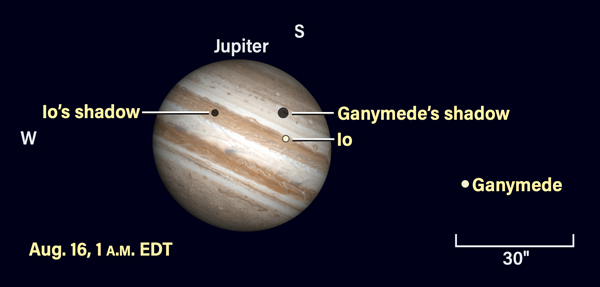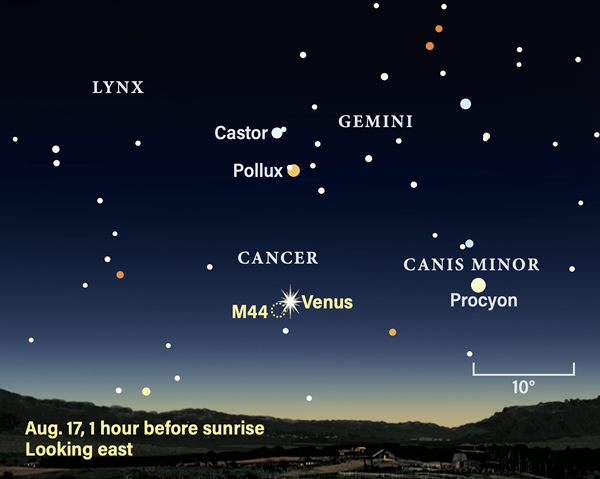Friday, August 12
The Perseid meteor shower peaks today with a still nearly Full Super Moon in the sky, which will make viewing all but the brightest fireballs difficult. For those at mid-northern latitudes or higher, the radiant in Perseus is always or nearly always above the horizon. So although meteor showers produce fewer shooting stars at night, when observers are on Earth’s trailing hemisphere, it’s still worth looking northeast late tonight, as the radiant in northern Perseus is slowly climbing higher in the sky. Because the Perseids are such an active shower, producing up to 100 meteors per hour at the peak, chances are still good that a few brighter meteors may grace your skies.
While you wait, however, there’s plenty else to enjoy in the evening sky. Bright targets are best, given the blazing Moon, so let’s focus on a favorite summertime asterism: the Summer Triangle. This large asterism straddles the plane of the Milky Way and is drawn from the stars Altair in Aquila the Eagle, Vega in Lyra the Lyre, and Deneb in Cygnus the Swan. The brightest point is Vega at magnitude 0; it sits just over 75° high in the east an hour after sunset. Next comes magnitude 0.8 Altair, which is 35° southeast of Vega (to its lower right) and is the lowest of the three stars in the sky (though it is 45° high at this time). Look 25° east-northeast (to the upper left) of Altair to land on magnitude 1.3 Deneb and complete the triangle’s shape.
Deneb marks the tail of the Swan, but Cygnus’ head is also a great target: 3rd-magnitude Albireo is a stunningly beautiful double star with contrasting colors of orange and blue. With 35″ between them, they can be resolved in either binoculars (10x) or any small telescope.
Sunrise: 6:09 A.M.
Sunset: 8:01 P.M.
Moonrise: 8:57 P.M.
Moonset: 6:32 A.M.
Moon Phase: Waning gibbous (99%)
*Times for sunrise, sunset, moonrise, and moonset are given in local time from 40° N 90° W. The Moon’s illumination is given at 12 P.M. local time from the same location.
Saturday, August 13
Mercury remains low in the evening sky all month, moving almost parallel to the horizon night by night. Today, it’s still relatively easy to spot at magnitude –0.1 after sunset. Mercury will continue fading through the rest of August, so now is the time to go looking for it. Half an hour after sunset, the small planet is 5° high in the west, beneath the not-yet-visible hindquarters of Leo the Lion. Through a telescope, Mercury’s disk appears 71 percent lit and is 6″ across. Mercury will reach its greatest eastern elongation from the Sun in two weeks, but will have faded to magnitude 0.3 by then.
You may spot a few bright stars nearby in the fading twilight: magnitude 1 Spica in Virgo and magnitude –0.1 Arcturus in Boötes. Wait a little longer, and Denebola at the tip of Leo’s tail and several of the stars in the Big Dipper will start to appear as well.
Sunrise: 6:10 A.M.
Sunset: 7:59 P.M.
Moonrise: 9:26 P.M.
Moonset: 7:49 A.M.
Moon Phase: Waning gibbous (96%)
Sunday, August 14
The Moon passes 3° south of Neptune at 6 A.M. EDT. The pair is visible early this morning before sunrise, though Neptune (at magnitude 7.7) will require binoculars or a small scope to see. The planet floats in southwestern Pisces, about 8° south of the Circlet asterism.
But the real showstopper today is Saturn, which reaches opposition at 1 P.M. EDT and is rising in Capricornus as the Sun sets. The ringed planet will be visible all night, setting around sunrise, but the best views come in the hours around midnight and into the early morning, when it is highest in the south.
In truth, though, anytime tonight is a great time to view Saturn, which glows at magnitude 0.2 just less than 2.5° northwest of Deneb Algedi. Through a telescope, the planet’s disk is 19″ across — but its rings are what we’re all here for, stretching 43″ across their major axis and 10″ along their minor axis. They’re currently tilted about 14° to our line of sight with their northern face lit. It’s the best view of the rings that we’ll get for another five years or so. In 2025, they will appear edge-on as we “cross” from one side of the rings’ plane to the other (from our point of view here on Earth). Magnify your view at least 100x to try spotting the dark Cassini Division, a 7″-wide gap between the outermost Ring A and the next ring in, Ring B.
Saturn is surrounded by an array of moons, several of which are within easy reach of amateur telescopes. Titan is brightest at magnitude 8.5 and sits about 1′ west-southwest of the planet’s center. Also scattered about are 10th-magnitude Tethys, Dione, and Rhea. Late tonight, Tethys sits 45″ due east of the planet, with Rhea 13″ to Tethys’ southeast and Dione 20″ southwest of Saturn’s disk. Iapetus, now around magnitude 11, is nearly 8′ due west of Saturn.
Sunrise: 6:11 A.M.
Sunset: 7:58 P.M.
Moonrise: 9:51 P.M.
Moonset: 9:02 A.M.
Moon Phase: Waning gibbous (90%)
Monday, August 15
The Moon passes 1.9° south of Jupiter at 6 A.M. EDT. Both are visible before sunrise in the south, hanging together in the far northwestern corner of Cetus the Whale. Even with the Moon’s bright disk nearby, you’ll likely still be able to easily spot Jupiter’s magnitude –2.7 glow.
We’ll come back to Jupiter overnight, but first, evening observers can try their hand at finding the mighty Andromeda Galaxy (M31) after the Sun sets but before the Moon rises. This massive spiral galaxy is larger than the Milky Way and resides in the constellation Andromeda, just 1.3° west of 5th-magnitude Nu (ν) Andromedae. (That’s within the field of view of a telescope, and certainly binoculars.)
M31 is technically visible with the naked eye with a magnitude of 3.6, but its large area — its long axis stretches roughly the same width as six Full Moons — means that it has a low surface brightness. This makes it difficult to spot without optical aid when it is close to the horizon or if your skies are at all light-polluted, so sweeping the area with binoculars or a small scope is your best bet tonight.
Just before midnight (on the East Coast), it’s time to return to Jupiter for the start of a stunning dual transit of Ganymede and Io, accompanied by the moons’ shadows. At 11:24 P.M. EDT, Io’s shadow kicks off the show as it slips onto Jupiter’s disk from east. Io itself is still 19″ east of Jupiter at that time, while Ganymede sits another 36″ east of Io. At 11:59 P.M. EDT, Ganymede’s large shadow begins to transit, taking several minutes to fully appear on the disk’s eastern edge.
Now, scroll down to continue the show on the morning of the 16th.
Sunrise: 6:12 A.M.
Sunset: 7:57 P.M.
Moonrise: 10:15 P.M.
Moonset: 10:11 A.M.
Moon Phase: Waning gibbous (83%)
Tuesday, August 16
This morning begins with a dual transit already underway across the face of Jupiter in the east. Io’s shadow sits roughly halfway across Jupiter’s face, while the much larger blot of Ganymede’s shadow lies to its southeast. Around 12:23 A.M. EDT, Io itself finally slips onto the disk; some 40 minutes later, Io has already caught up to Ganymede’s slow-moving shadow. The small moon passes the larger shadow within half an hour.
Io’s shadow continues across the disk until 1:38 A.M. EDT, with Io itself slipping off the western limb less than an hour later, just after 2:30 A.M. EDT. Ganymede’s shadow falls away around 3 A.M. EDT. And then, finally, Ganymede itself is ready to have a go, crossing onto Jupiter’s disk at 4:09 A.M. EDT. It will continue across for an hour and a half, leaving the disk at 5:39 A.M. CDT (note the time change, as this is after sunrise on the East Coast but just as twilight is breaking in the Midwest).
There’s also an added bonus: The Great Red Spot is visible on Jupiter’s Earth-facing side this morning as well, reaching the center of the planet just after 2 A.M. EDT.
Sunrise: 6:12 A.M.
Sunset: 7:55 P.M.
Moonrise: 10:39 P.M.
Moonset: 11:19 A.M.
Moon Phase: Waning gibbous (74%)
Wednesday, August 17
The planet Venus pays the Beehive Cluster a visit this morning, appearing less than 1° west of the open star cluster (also cataloged as M44). You can’t miss Venus’ bright magnitude –3.9 light, nearly 5° high in the east an hour before sunrise. In the quickly brightening sky, you’ll want to pull out binoculars to better see the Beehive Cluster beside it, a sparkling group of stars with a total magnitude of 3.1. Like Andromeda, however, the Beehive is spread out on the sky, covering nearly 3° and reducing its surface brightness significantly. The cluster will really pop through your binoculars, small scope, or even your finder scope, sitting smack dab in the middle of Cancer. (Remember, make sure to stop observing with any equipment several minutes before sunrise, to be safe.)
Venus itself spans 10″ and is now 95 percent lit. Its phase will grow slightly throughout the month, ending August as a 97-percent-lit disk.
Sunrise: 6:13 A.M.
Sunset: 7:54 P.M.
Moonrise: 11:05 P.M.
Moonset: 12:24 P.M.
Moon Phase: Waning gibbous (65%)
Thursday, August 18
The Moon passes 0.6° north of Uranus at 11 A.M. EDT; an hour before sunrise, the two are 2° apart high in the southeastern sky. Like Neptune, Uranus is faint enough that you’ll need optical aid to see it. Fortunately, the Moon has waned a bit more and shouldn’t wash out the distant planet’s magnitude 5.8 glow too badly in your binoculars or small scope.
Also visible this morning is Orion the Hunter, fully above the horizon by around 3:30 A.M. local time and more than 25° high an hour before dawn. His famous belt, which contains the three stars Alnitak, Alnilam, and Mintaka, is easy to pick out in the still-dark sky. But the Hunter’s most famous star is probably Betelgeuse, which is typically depicted as Orion’s right shoulder (his figure is most often drawn facing us). This magnitude 0.5 star is an aging red giant whose brightness is variable, changing by about 3x over a period of 11 months. Plus, unexpected changes in brightness can also occur, as happened in late 2019.
Sunrise: 6:14 A.M.
Sunset: 7:53 P.M.
Moonrise: 11:34 P.M.
Moonset: 1:30 P.M.
Moon Phase: Waning gibbous (55%)
Friday, August 19
Last Quarter Moon occurs at 12:36 A.M. EDT, while later this morning, the Moon passes 3° north of Mars at 8 A.M. EDT. Check in with the pair a bit earlier, when they are closer together — just 2° apart, with the Moon to Mars’ northwest — high in the southeastern sky an hour before sunrise. Together, the two hang in Taurus just over 4.5° south of the famous Pleiades open star cluster. The three objects form a line from north to south, from the Pleiades through the Moon to Mars.
The Red Planet shines this morning at magnitude 0, making its ruddy glow easy to pick out among the nearby stars. Compare it to Aldebaran, the magnitude 0.1 eye of the Bull, whose light also has a reddish hue. This star sits nearly 11.5° east-southeast of Mars. Continue roughly along a line drawn from Mars to Aldebaran, and 21.5° farther east-southeast of Aldebaran is Betelgeuse in Orion, a similarly red jewel in the predawn sky.
Sunrise: 6:15 A.M.
Sunset: 7:51 P.M.
Moonrise: —
Moonset: 2:33 P.M.
Moon Phase: Waning crescent (45%)













